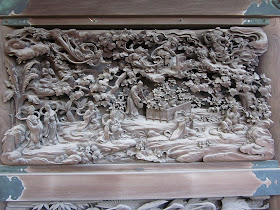Quite a sight, isn't it? I was not prepared for a work like this to come from the temple of a small town in Tokyo not mentioned in any of the guidebooks that I've seen. It's one of the most incredible sites I've seen in Japan. Its carvings are on par or better than those of Tōshō-gū in Nikko. The center panels on the walls are the main panels, 10 in all that depict parts of the story found in the Lotus Sutra, specifically regarding the Medicine King. [1] These 10 panels were carved in the early part of the Showa Period (1926-1989) under the guidance of the 16th head priest Nissai. [2]
While entering the temple itself is free, this area costs some money (possibly 400 yen). It's definitely worth every last one of them, as it's an incredible site, and my pictures can't do justice to what it looks and feels like being up close to the panels. However, for those unable to make the trip, here are some detail shots of the carvings.
 |
| The center of the walls leading up to the roof. |
The rest of the walls are broken up into 10 frames, with the central panel to each frame being the important one depicting a story found in the Lotus Sutra. However, each section also has other panels of decorative carvings around the main panel. These other panels are all similar to each other at their respective height. The layout to the wall sections from top to bottom is: First is a small carving of one of the animals of the zodiac. Next, is the carving of a Tennyo (天女). Tennyo are the Japanese name for female Apsaras. Apsaras are the Hindu and Buddhist female spirits of clouds and water; also known as Celestrial Maidens. [3] After this, is the main panel and at the bottom are depictions of herons in various settings.
The first panel:
 |
| The main panel for the first section. |
 |
| Detail of the first main panel. |
 |
| Each panel has an explanation of the section of the Lotus Sutra that the main panel depicts. |
The second panel:
The third panel:
 |
| These are the gods Fūjin (風神) and Raijin (雷神), the Japanese Shinto gods of wind and thunder respectively. |
The fourth panel:
The fifth panel:
The sixth panel:
The seventh panel:
The eighth panel:
The ninth panel:
The tenth panel:
After viewing the 10 panels, there is a small staircase that leads down to the base of the building. There are also carvings along the walls of this path.
At the bottom of the staircase is the base of Taishaku-do, which is also carved. The panels here depict different seasons and the most impressive of the dragon carvings can be found here.
Here are some of the panels in the base of the building. They depict different birds and plants famous for certain seasons.
Flanking both sides of these panels were the impressive dragon guardians on the base of Taishaku-do.
This is the last spot to see of the beautiful Taishaku-do. So with one final look back
we head out of Taishakuten. Before leaving Shibamata entirely, we decided to get something to eat first.
 |
| Shibamata's speciality Dango. I talked about Dango last time. |
While we had finished with Shibamata for the day, there are still things we weren't able to do and need to go back to see. The first is Taishakuten's Goshuin which we weren't able to get. Normally shrines and temples always offer Goshuin, but Taishakuten's busiest time of the year was during this time. Their biggest celebrations are the holidays of New Year's and Setsubun, which is a Japanese holiday in the beginning of February that I will be talking about next time. Due to this, they weren't offering the Goshuin until after Setsubun, so it's something we will have to go back to.
Another interesting activity in Shibamata is finding the 7 temples of the Seven Gods of Good Luck in Shibamata. The Seven Gods of Good Luck are Shichi Fukujin (七福神) in Japanese. In Shibamata, there are 7 temples that house an image of one of the Shichi Fukujin. These are scattered about town so it makes for an interesting spiritual scavenger hunt. It's something I look forward to doing the next time we return to Shibamata.
References:
1. "About Shibamata Taishakuten," Taishakuten-Daikyoji.
http://www.taishakuten.or.jp/index2.html.
2. Ibid.
3. Mark Schumacher, "天人," Onmakrproductions.com.
http://www.onmarkproductions.com/html/karyoubinga.html#tennyo.






























































No comments:
Post a Comment